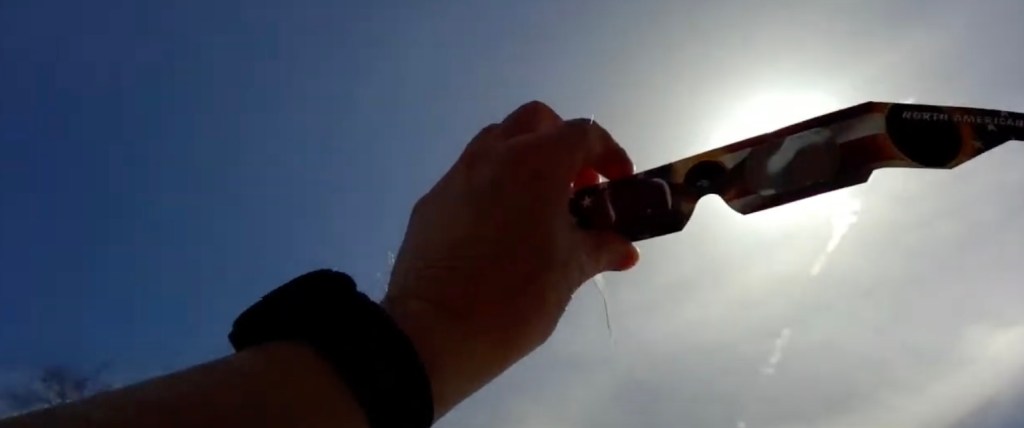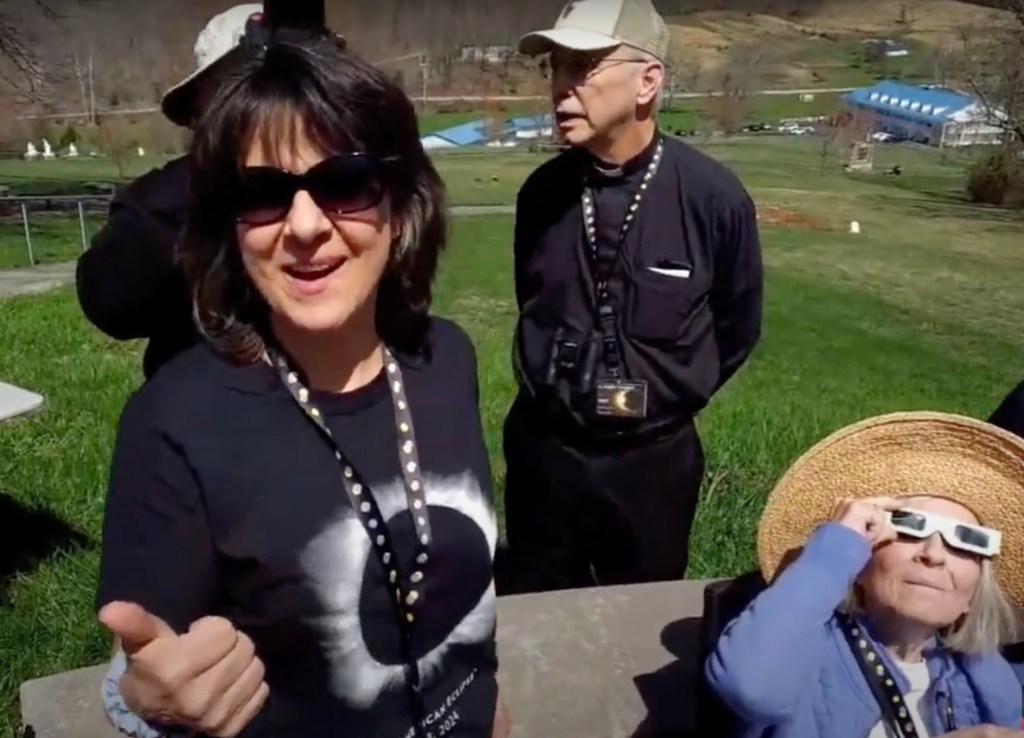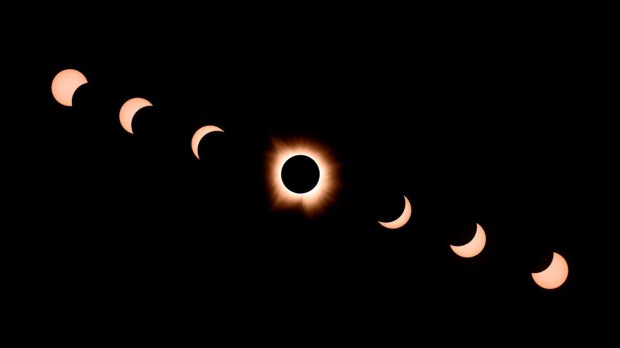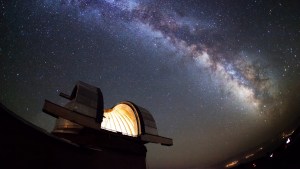No doubt you have heard a lot of “Eclipse 2024” stories. I think the best you will hear is that of the “Total Solar Eclipse Faith & Science Retreat” at the Mother of the Redeemer Retreat Center near Bloomington, Indiana, in the USA. This retreat was not organized by the Vatican Observatory, but there were a lot of people with VO connections there. Br. Guy Consolmagno, the Director of the VO was there. So was Fr. James Kurzynski, the priest who provided the impetus for the VO’s biennial Astronomy for Catholics in Ministry and Education (ACME) program and who writes for the VO’s blog, Sacred Space Astronomy. So was Dr. Brenda Frye, who has also written for Sacred Space, among various other things (more about her in a minute). I was there too.
This retreat was located in the bucolic countryside of Indiana west of Bloomington. Think of rolling hills, bubbling brooks, woods just beginning to show faint halos of green and gold. White wildflowers are popping up everywhere. Redbud trees line the edges of woods, in their full glow of … pink (not red).
The retreat was attended by roughly a dozen priests and even a couple of bishops, but most of the attendees were ordinary laypeople. Most of those laypeople had no scientific training, or perhaps owned a small telescope and did some stargazing or astro-photography. Some had never even looked through a telescope before. Some were young parents, so there were a couple of 18-month-olds crawling around on the floor and occasionally making noise or trying to get up onto the speakers’ platform. Tech support was handled by a group of Franciscan friars whose community (The Franciscans of the Immaculate) is adjacent to the retreat center.

There was food, time for socializing, and even some live music. There was stargazing one clear night. We turned smallish, portable telescopes to Jupiter and its moons, all setting in the west; to the Pleiades (or Subaru — that’s why those cars have a starry emblem on them); to the Orion nebula; to the stars Sirius the Dog Star (white in color) and Betelgeuse in Orion (red-orange — a cooler star than white-hot Sirius). There was prayer, and — at the Sacred Heart Chapel there — Masses, confessions, and a Divine Mercy celebration. The grounds were spread across a broad hillside, offering views at various elevations of the hills and woods and sky. The hillside also featured a Stations of the Cross walk, a Rosary walk, and a Seven Sorrows of Mary walk.
Latest and best in science
And then there was the science. This retreat included discussions of the absolute latest and best in scientific research from some leading scientists. You don’t find that everywhere! These scientists included Br. Guy, of course, but also Dr. Jeffrey Cooke, and Dr. Brenda Frye.
Dr. Cooke is a friend of Fr. Timothy Sauppé (himself a friend of the Vatican Observatory, an ACME alumnus, and pastor of St. Mary’s Church in Westville, Illinois) who organized the entire event. Cooke talked about his work in gravitational waves and trying to detect optical signals from events that generate strong bursts of gravitational waves. He and Fr. Sauppé also attempted some cheesy comedy, full of Mel Brooks and Monty Python references. After the eclipse, Cooke was heading off to go observe with the Keck telescope in Hawaii, one of the world’s largest.
Dr. Frye’s discussion was truly remarkable. She is an Associate Professor of Astronomy at the University of Arizona who studies the formation and evolution of galaxies. She also leads an international team that works with the James Webb Space Telescope (JWST).
Her team’s discovery was so important that NASA decided to disrupt the JWST’s schedule, interrupting the previously planned JWST work, in order to go back and look again at the stuff Frye and her team had discovered.
Her team made a recent discovery of a distant supernova (an exploding star) in a galaxy far, far, far away — a galaxy whose light had been multiply bent and distorted by the gravitational field of a cluster of other galaxies such that multiple images of this exploding star were visible to the JWST. Her team’s discovery was so important that NASA decided to disrupt the JWST’s schedule, interrupting the previously planned JWST work, in order to go back and look again at the stuff Frye and her team had discovered.
That’s right, NASA stopped what the James Webb Space Telescope was doing because Brenda Frye needed the telescope.
Excited and nervous
Frye and her team derived from their work a new, direct measurement of the rate of expansion (also known as the “Hubble constant”) of the universe — the expansion that emerged from the “Big Bang” first theorized a century ago by Fr. George LeMaître, the Belgian priest and physicist. The Frye team has been cranking out multiple papers on this discovery; those papers are being published by the leading scientific journals. The team’s first discovery paper was the first JWST result to be submitted for publication from a US team, and only the second worldwide.
Dr. Frye, who is Jewish, talked about all of this at a Catholic retreat center in rural Indiana, to a mixed group who were there because of both science (the eclipse) and faith.
You can watch her talk here.
Dr. Frye told the retreatants that this talk was the first time she had ever publicly enunciated the expansion rate she found (she has put it in writing in a paper, but not verbally). She also told us that at one point she was so excited and nervous, with anticipation about whether NASA would really let her team commandeer the JWST, that she had to get her teenage son to read her e-mail to her aloud. (Her husband was minding her crew of kids, all teens or older, while she was at the retreat for a few days.)
All the talks at the retreat are available from the Franciscans of the Immaculate here.
Joyful hubbub
Also available from the Franciscans is a chaotic live-stream of the eclipse itself, and of all the joyful hubbub surrounding the eclipse as a large group of retreatants — religious and lay people, “average Joes and Janes,” and top-notch scientists — observed near the Sacred Heart Chapel. As can be seen in the live-stream, the weather was excellent.

The whole eclipse event was truly remarkable. It was perhaps the sort of thing that people who hold to certain stereotypes about religious people and science might never imagine. The best of the science of astronomy was at this joyful Catholic retreat, all leading up to the magnificent eclipse in clear blue skies on the Feast of the Annunciation (this year on April 8, because March 25, the usual date for the Annunciation, was during Holy Week, and because of the Octave of Easter). This was “faith and science.” And that is why this was the best “Eclipse 2024” story you will hear.
Live-stream is here.


